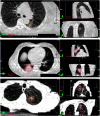Shallow kinetics induced by a metronome (SKIM): A novel contactless respiratory motion management
- PMID: 37672210
- PMCID: PMC10691643
- DOI: 10.1002/acm2.14147
Shallow kinetics induced by a metronome (SKIM): A novel contactless respiratory motion management
Abstract
Objectives: As an alternative to conventional compression amidst the COVID-19 pandemic, we developed a contactless motion management strategy. By increasing the patient's breathing rate to induce shallow breathing with the aid of a metronome, our hypothesis is that the motion magnitude of the target may be minimized without physical contact or compression.
Methods: Fourteen lung stereotactic body radiation therapy (SBRT) patients treated under fast shallow-breathing (FSB) were selected for inclusion in this retrospective study. Our proposed method is called shallow kinetics induced by a metronome (SKIM). We induce FSB by setting the beats-per-minute (BPM) high (typically in the range of 50-60). This corresponded to a patient breathing rate of 25-30 (breathing) cycles per minute. The magnitude of target motion in 3D under SKIM was evaluated using 4DCT datasets. Comparison with free breathing (FB) 4DCT was also made for a subset for which FB data available.
Results: The overall effectiveness of SKIM was evaluated with 18 targets (14 patients). Direct comparison with FB was performed with 12 targets (10 patients). The vector norm mean ± SD value of motion magnitude under SKIM for 18 targets was 8.2 ± 4.1 mm. The mean ± SD metronome BPM was 54.9 ± 4.0 in this group. The vector norm means ± SD values of target motion for FB and SKIM in the 12 target sub-group were 14.6 ± 8.5 mm and 9.3 ± 3.7 mm, respectively. The mean ± SD metronome BPM for this sub-group was 56.3 ± 2.5.
Conclusion: Compared with FB, SKIM can significantly reduce respiratory motion magnitude of thoracic targets. The difference in maximum motion reduction in the overall vector norm, S-I, and A-P directions was significant (p = 0.033, 0.042, 0.011). Our proposed method can be an excellent practical alternative to conventional compression due to its flexibility and ease of implementation.
Keywords: fast shallow-breathing (FSB); free breathing (FB); metronome; motion management; stereotactic body radiation therapy (SBRT).
© 2023 The Authors. Journal of Applied Clinical Medical Physics published by Wiley Periodicals, LLC on behalf of The American Association of Physicists in Medicine.
Conflict of interest statement
The authors declare no conflicts of interest.
Figures





References
-
- Keall PJ, Mageras GS, Balter JM, et al. The management of respiratory motion in radiation oncology report of aapm task group 76 a. Med Phys. 2006;33:3874‐3900. - PubMed
-
- Korreman SS. Motion in radiotherapy: photon therapy. Phys Med Biol. 2012;57:R161. - PubMed
-
- Van den Begin R, Engels B, Gevaert T, et al. Impact of inadequate respiratory motion management in sbrt for oligometastatic colorectal cancer. Radiother Oncol. 2014;113:235‐239. - PubMed
-
- Caillet V, Booth JT, Keall P. Igrt and motion management during lung sbrt delivery. Physica Med. 2017;44:113‐122. - PubMed
MeSH terms
LinkOut - more resources
Full Text Sources
Medical
Research Materials

